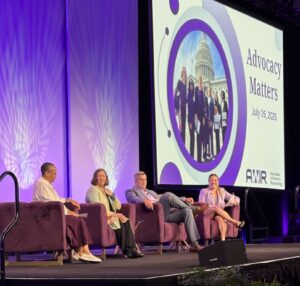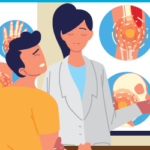Strengthening advocacy and advancing ongoing collaboration were two goals successfully met at the Association of Women in Rheumatology (AWIR) annual conference July 24–26 in Orlando, Fla.

AWIR and ACR experts shared updates during an advocacy session at the AWIR annual conference. From left: Gwenesta B. Melton, MD, FACR; Stephanie Ott, MD, FACR; Kevin Daley; and Paige Colston.
During a joint education session, advocacy experts from the AWIR and the ACR’s Paige Colston, manager of PAC and grassroots engagement, presented on the organizations’ collaborative successes and ongoing goals. In particular, Ms. Colston talked about RheumPAC and increased awareness of the ACR’s advocacy efforts in the rheumatology community.
Joining for a Common Cause
Ms. Colston describes AWIR’s annual conference as an entry point for attendees to learn about the ACR’s work, especially those who are earlier on in their careers. She was also able to promote many of the ACR’s advocacy resources, like the weekly D.C. Office Update and payer advocacy. “Breaking through via email can be difficult, so these in-person interactions can bridge that gap,” she says.
AWIR Vice President Gwenesta B. Melton, MD, FACR, who is also Advocacy Co-chair for AWIR and chair of the ACR’s Affiliate Society Council, co-led the advocacy education session with AWIR Advocacy Co-chair Stephanie Ott, MD, FACR. Dr. Melton says the advocacy mission, goals and priorities of AWIR are all developed and executed to gain the highest quality and access of care for rheumatic patients—ideals that are shared and championed with the ACR. “Collaboration between AWIR advocacy leaders and ACR advocacy titans Paige Colston and Joseph Cantrell, JD, through our meeting and throughout the year forms an alliance that amplifies our voices locally, regionally and nationally,” she says.
Advancing Shared Missions
The AWIR leverages advocacy and legislative changes to promote equitable healthcare for patients with rheumatic disease, particularly for women. For example, the AWIR legislative priorities for 2025–2026 frame the following advocacy goals:
- Support legislation to ban accumulator adjustment programs (AAPs) to ensure copay
- assistance applies toward deductibles and out-of-pocket maximums;
- Oppose regulations that set upper payment limits (UPLs), which create access challenges for patients and negatively impact providers that buy-and-bill;
- Advocate for transparency in drug pricing and mandates to require pharmacy benefit managers (PBMs) and insurers to pass through rebates to patients and unlink compensation from the price of the drug;
- Promote fair access to treatment and care irrespective of race, gender or socioeconomic status;
- Address wage disparities affecting female healthcare providers in rheumatology;
- Advocate for federal solutions to address the shortage of healthcare professionals in rheumatology;
- Support changes to improve patient access to care by ensuring fair reimbursement rates based on inflation;
- Promote policies that provide exceptions to step therapy protocols; and
- Advocate legislation that impacts continuity of care for patients.
The AWIR’s mission aligns perfectly with the ACR’s commitment to advance the practice of rheumatology, Ms. Colton explains. Additionally, many AWIR members are also members of the ACR, underscoring the complementary roles that the two organizations play in the professional life of rheumatologists or rheumatology professionals.

